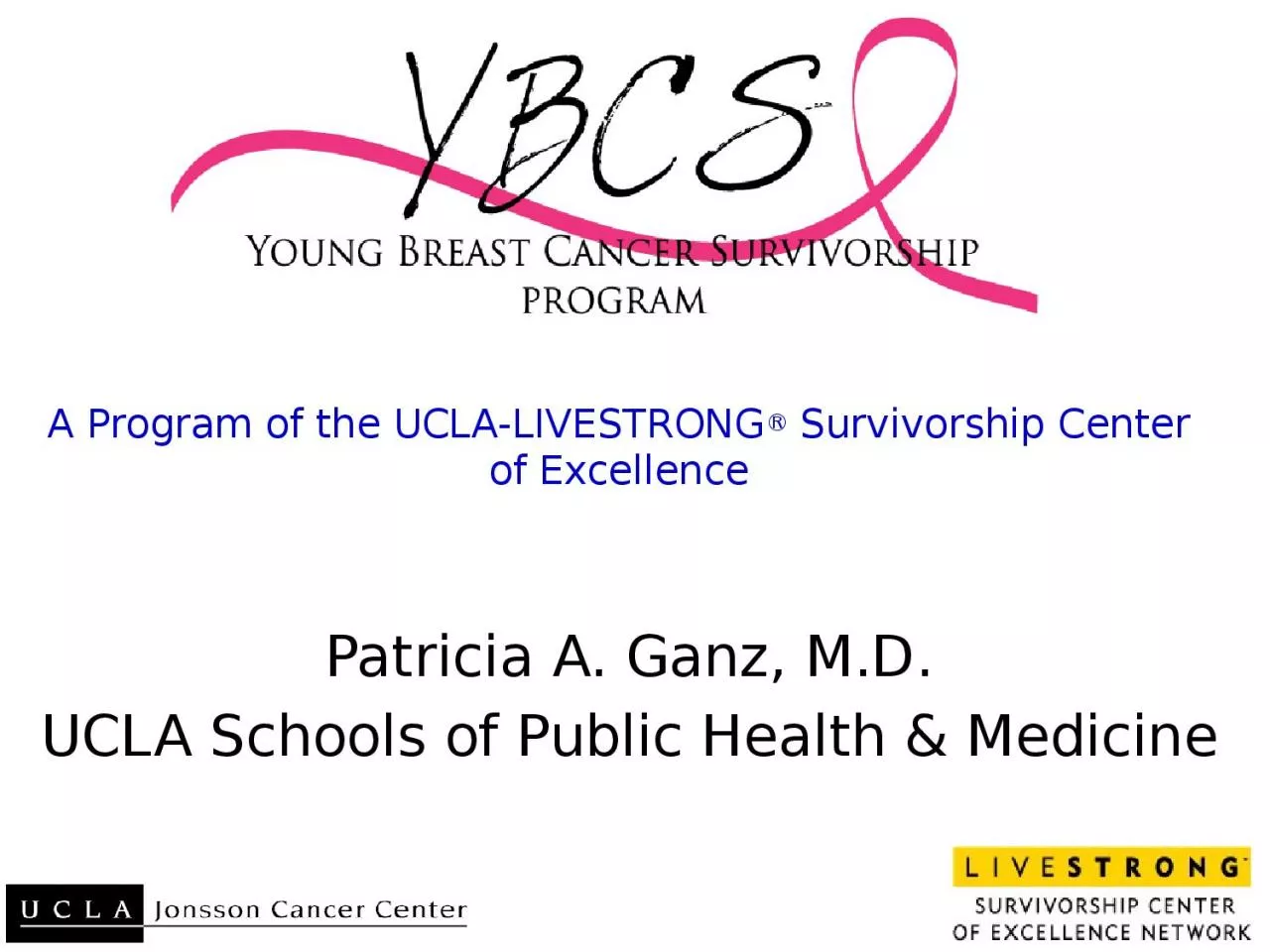

Survivorship Center of Excellence Patricia A Ganz MD UCLA Schools of Public Health amp Medicine UCLALIVE STRONG Survivorship Center of Excellence Testing Models of Survivorship Care ID: 1042887
Download Presentation The PPT/PDF document "A Program of the UCLA-LIVESTRONG" is the property of its rightful owner. Permission is granted to download and print the materials on this web site for personal, non-commercial use only, and to display it on your personal computer provided you do not modify the materials and that you retain all copyright notices contained in the materials. By downloading content from our website, you accept the terms of this agreement.
1. A Program of the UCLA-LIVESTRONG® Survivorship Center of ExcellencePatricia A. Ganz, M.D.UCLA Schools of Public Health & Medicine
2. UCLA-LIVESTRONG® Survivorship Center of Excellence: Testing Models of Survivorship CareUCLA
3. Los Angeles County as a LaboratoryMost populous and diverse county in the US 9,818,605 residents 74.5 % 18 years and older 10.9% 65 years and older 50.3% White, 8.7% Black or African American, 13.7% Asian, 0.7% American Indian or Alaska Native, 0.3% Native Hawaiian/Other Pacific Islander, 23.5% some other race, 4.9% two or more races; 44.7 % self-identified as Hispanic or Latino ; 27% non-Hispanic white35.6% foreign born(source, US census data, 2010)
4. COE Management TeamInternal RelationshipsExternal RelationshipsExternal ScientificAdvisory CommitteeCommunity Advisory BoardInternal Steering CommitteeCommunityCollaboratorsUCLA-LIVESTRONG® Survivorship COE Organizational Chart
5. UCLA/JCCC Perspective on SurvivorshipThe Patients and Survivors program has as its major goal the reduction in avoidable morbidity and mortality among patients with cancer including long-term survivors Our research focuses on quality of life across the developmental life span and the measurement and evaluation of the quality of cancer care
6. and UCLA Medical CenterFifth ranked medical center in the USBest Cancer Care in California
7. VITA stands for.... “Vital Information and Tailored Assessment”The VITA Program is the clinical arm ofUCLA-LIVESTRONG Survivorship COEhttp://vita.mednet.ucla.edu/
8. Fully accredited, full-service, 376 bed, nonprofit community medical center. The South Bay’s first hospital, founded in 1971Highest recognition in the community for quality and state-of-the-art medical services in a 2004 survey conducted by National Research Corporation. Selected as a Top 100 U.S. Hospital (2004, Solucient). Accredited by the American College of Surgeons Cancer ProgramHospital cancer registry, with 1300 incident cases/yearPhysicians at Health Care Partners Medical Group admit to TMMC
9. A 377-bed-state-of-the-art County facility built in 1987In 1992, Olive View incorporated UCLA in its name becoming Olive View-UCLA Medical CenterIn May 1997, Olive View-UCLA Medical Center became a part of ValleyCare, a healthcare delivery system for the north San Fernando Valley, Los Angeles County Department of Health Services
10. Michelle Doose-Peña, MPH, CHESProgram CoordinatorUCLA Healthy Lives After Cancer Program…supporting teen & young adult survivors!Email: mdoose@mednet.ucla.eduFacebook: www.facebook.com/HealthyLivesAfterCancer Webpage: www.cancer.ucla.edu/HealthyLivesAfterCancer
11.
12. Fertility Preservation ServicesUCLA Survivorship Center NP attended MSKCC Conference in October 2011 and met with NP in charge of fertility services consultationConducted survey among UCLA oncologists and other providers to assess knowledge and attitudes towards these servicesWorking with reproductive endocrinologists to develop in house referral program as well as regional resources
13. CDC Funding Received in September 2011 for three years.www.facebook.com/YBCSprogram
14. Scope of Project
15. Needs Assessment Community Organization AssessmentPatient / Survivor Interviews
16. 23 Community Organization InterviewsTriple StepToward the Cure
17. Needs Assessment – Community Organizations - Summary of FindingsGaps in services#1 – Programs targeted toward young adults 21-45FertilityEarly menopause/menopause symptomsSexual functioning issuesBody imageManaging work/careerTop recurring issues-Fatigue-Fear of recurrence-Side effects of treatmentChemobrainPsychological issuesFertilityReturn to work
18. Needs Assessment – Patient Interviews - Summary of FindingsGapsSupport groups for younger womenFertilityMentor/buddy matching programRecurring IssuesFatigueCognitive issues – ChemobrainFear of recurrenceNeedsCoping with the “new normal” post treatment – long term survivorship Healthy lifestyle changesSupport groups for younger women Total 18 interviews Age range (at diagnosis): 27 to 45 Age range (current): 29 to 54
19. Needs Assessment – Comparison of FindingsGaps in services-Programs targeted toward young adults 21-45FertilityEarly menopause/menopause symptomsSexual functioning issuesBody imageManaging work/careerGapsSupport groups for younger womenFertilityMentor/buddy matching programCommunity OrganizationsBreast Cancer Patients
20. Needs Assessment – Comparison of FindingsRecurring issues-Fatigue-Fear of recurrence-Side effects of treatment -Chemobrain -Psychological issues -Fertility -Return to workRecurring IssuesFatigueCognitive issuesChemobrainFear of recurrenceCommunity OrganizationsBreast Cancer Patients
21. Needs Assessment – Comparison of FindingsNeedsCoping with the “new normal” post treatment – long term survivorship Healthy lifestyle changesSupport groups for younger womenBreast Cancer Patients
22. Needs assessment – Lessons Learned- Confirmed literature and clinical experience- Identified specific regional gaps in services- Helped to prioritize strategies for program development- Honing in on unique population needs that are difficult to address within large organizations
23. Internal Advisory Committee - NotesPriorities Fear of recurrence Coping with the “new normal” Chemobrain Fatigue Reproductive & fertility services Early menopause/menopause symptoms Sexuality & Intimacy issuesMission Statement
24. Mission StatementThe Young Breast Cancer Survivorship (YBCS) program is dedicated to enhancing the health and wellness of young survivors of breast cancer. Our goal is to address the unique gaps in services that exist for this population by providing a regionally refined community resource listing of programs and services that cater to the specific challenges that young survivors face. The YBCS program especially focuses on psychosocial support services and educational programs aimed at providing education on coping with various psychosocial issues.
25. Next Steps – Program ImplementationPsychosocial program development in processOnline resource library Awarded grant funding from UCLA’s Clinical and Translational Science Institute (CTSI) Development of regional resources focused on reproductive services and fertility preservation
26. Media/MarketingFacebook Page www.facebook.com/YBCSprogramUCLA Jonsson Comprehensive Cancer Center Website www.cancer.ucla.edu/YBCS
27. Upcoming EventsSurvivor Education Day *Special YBCS afternoon session
28. Questions?